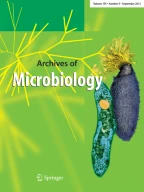Abstract
Klebsiella aerogenes NCTC 418 was cultured anaerobically in chemostat cultures (pH 6.8; 35° C) under carbon, phosphate-, ammonia-, sulphate- and potassium-limited conditions with glucose as the sole carbon- and energy source. The rates of uptake of glucose and excretion of fermentation products were quantitatively determined and carbon, hydrogen- and oxygen balances were constructed with recoveries better than 90%.
It was found that under glucose-limited conditions the utilization of the carbon source was the most efficient. Under these conditions the highest Y GLU was obtained whilst virtually all glucose was fermented to acetate and ethanol and formate plus carbon dioxide. Under all glucose-sufficient conditions a branched fermentation was observed with acetate, ethanol, formate plus carbon dioxide, D-lactate, succinate and 2,3-butanediol as end-products. The lower Y GLU values for these cultures appeared to be a consequence of both a decreased Y ATP and a decreased efficiency of ATP synthesis from the dissimilation of glucose. In contrast to aerobic cultures, significant differences in fermentation patterns were not observed between the various glucose-sufficient cultures.
The fermentation patterns of glucose-sufficient cultures appeared to be influenced by the specific growth rate. For all these cultures a lowering of the dilution rate resulted in a smaller fraction of glucose being fermented to acetate and a greater fraction being fermented to 2,3-butanediol. Relatively much glucose was fermented to D-lactate when the organisms were grown at a low dilution rate under sulphate-limited conditions.
Anaerobic, glucose-limited cultures were found to be able to increase their specific uptake rate of glucose instantaneously when pulsed with glucose. The extra glucose taken up was fermented mainly to D-lactate whilst no increase in the specific production rate of acetate and ethanol occurred. The excreted D-lactate probably was not formed from pyruvate, by the NADH-linked lactate dehydrogenase, but via the methylglyoxal bypass. It is suggested that by invoking this bypass reaction K. aerogenes can metabolically uncouple ATP synthesis from glucose dissimilation, and herein may lie the physiological significance of this reaction sequence.
Similar content being viewed by others
References
Bernt E, Gutmann I (1974) Äthanol. Bestimmung mit Alkohol-Dehydrogenase und NAD. In: Bergmeyer HU (Hrsg) Methoden der enzymatischen Analyse, 3. Aufl, Bd II. Verlag Chemie, Weinheim, S 1545–1548
Carlsson J (1973) Simplified gas chromatographic procedure for identification of bacterial metabolic products. J Appl Microbiol 25:287–289
Cooper RA (1975) The methylglyoxal by-pass of the Embden-Meyerhof pathway. Biochem Soc Trans 3:837–840
Czok R, Lamprecht W (1974) Pyruvat, Phosphoenolpyruvat und D-Glycerat-2-phosphat. In: Bergmeyer HU (Hrsg) Methoden der enzymatischen Analyse, 3. Aufl, Bd II. Verlag Chemie, Weinheim, S 1491–1496
Dagley S (1974) Citrat, UV-spektrophotometrische Bestimmung. In: Bergmeyer HU (Hrsg) Methoden der enzymatischen Analyse, 3. Aufl, Bd II, Verlag Chemie, Weinheim, S 1607–1611
Evans CGT, Herbert D, Tempest DW (1970) The continuous cultivation of micro-organisms. 2. Construction of a chemostat. In: Norris JR, Ribbons DW (eds) Methods in microbiology, vol 2. Academic Press, London New York, pp 277–327
Gawhen K, Bergmeyer HU (1974) D-(-)-lactat. In: Bergmeyer HU (Hrsg) Methoden der enzymatischen Analyse, 3. Aufl, Bd II. Verlag Chemie, Weinheim, S 1538–1541
Gottschalk G (1979) Bacterial metabolism. In: Starr MP (ed) Springer series in microbiology. Springer, New York
Herbert D, Kornberg HL (1976) Glucose transport as rate-limiting step in the growth of Escherichia coli on glucose. Biochem J 156:477–480
Herbert D, Phipps PJ, Strange RE (1971) Chemical analysis of microbial cells. In: Norris JR, Ribbons DW (eds) Methods in microbiology, vol 5B. Academic Press, London New York, pp 209–344
Herbert D, Phipps PJ, Tempest DW (1965) The chemostat: Design and instrumentation. Lab Pract 14:1150–1161
Hernandez E, Johnson MJ (1967) Anaerobic growth yields of Aerobacter cloacae and Escherichia coli. J Bacteriol 94:991–995
Holz G, Bergmeyer HU (1974) Acetat, Bestimmung mit Acetatkinase und Hydroxylamin. In: Bergmeyer HU (Hrsg) Methoden der enzymatischen Analyse, 3. Aufl, Bd II. Verlag Chemie. Weinheim, S 1574–1578
Hueting S, Lange T de, Tempest DW (1979) Energy requirement of maintenance of the transmembrane potassium gradient in Klebsiella aerogenes NCTC 418: A continuous culture study. Arch Microbiol 123:183–188
Kornberg HL (1973) Fine control of sugar uptake by Escherichia coli. Symp Experimental Biology, No XXVII: Rate control of biological processes. Cambridge University Press, Cambridge
Lang E, Lang H (1972) Spezifische Farbreaktion zum direkten Nachweis der Ameisensäure. Z Anal Chem 260:8–10
Lowry OH, Rosebrough NJ, Farr AL, Randall RJ (1951) Protein measurement with the Folin phenol reagent. J Biol Chem 193:265–275
Neijssel OM, Sutherland-Miller TO, Tempest DW (1978) Pyruvate reductase and D-lactate dehydrogenase: A possible mechanism for avoiding energy conservation at site 1 of the respiratory chain in Klebsiella aerogenes. Proc Soc Gen Microbiol 5:49
Neijssel OM, Tempest DW (1975) The regulation of carbohydrate metabolism in Klebsiella aerogenes NCTC 418 organisms, growing in a chemostat. Arch Microbiol 106:251–258
Neijssel OM, Tempest DW (1976a) The role of energy spilling reactions in the growth of Klebsiella aerogenes NCTC 418 in aerobic chemostat culture. Arch Microbiol 110:305–311
Neijssel OM, Tempest DW (1976b) Bioenergetic aspects of aerobic growth of Klebsiella aerogenes NCTC 418 in carbon-limited and carbon-sufficient chemostat culture. Arch Microbiol 107:215–221
Neijssel OM, Tempest DW (1979) The physiology of metabolite overproduction. Symp Soc Gen Microbiol 29: Microbial technology: Current state, future prospects. In: Bull AT, Ellwood DC, Ratledge C (eds). Cambridge University Press, Cambridge, pp 53–82
Tempest DW, Neijssel OM (1978) Eco-physiological aspects of microbial growth in aerobic nutrient-limited environments. In: Alexander M (ed) Advances in microbial ecology, vol 2. Plenum Press, New York London, pp 105–153
Wallace RJ (1978) Control of lactate production by Selenemonas ruminantium; homotropic activation of lactate dehydrogenase by pyruvate. J Gen Microbiol 107:45–92
Westerfeld WW (1945) A colorimetric determination of blood acetoin. J Biol Chem 161:495–502
Williamson JR (1974) Succinat. In: Bergmeyer HU (Hrsg) Methoden der enzymatischen Analyse 3. Aufl, Bd II. Verlag Chemie, Weinheim, S 1661–1666
Author information
Authors and Affiliations
Rights and permissions
About this article
Cite this article
Teixeira de Mattos, M.J., Tempest, D.W. Metabolic and energetic aspects of the growth of Klebsiella aerogenes NCTC 418 on glucose in anaerobic chemostat culture. Arch. Microbiol. 134, 80–85 (1983). https://doi.org/10.1007/BF00429412
Received:
Accepted:
Issue Date:
DOI: https://doi.org/10.1007/BF00429412



